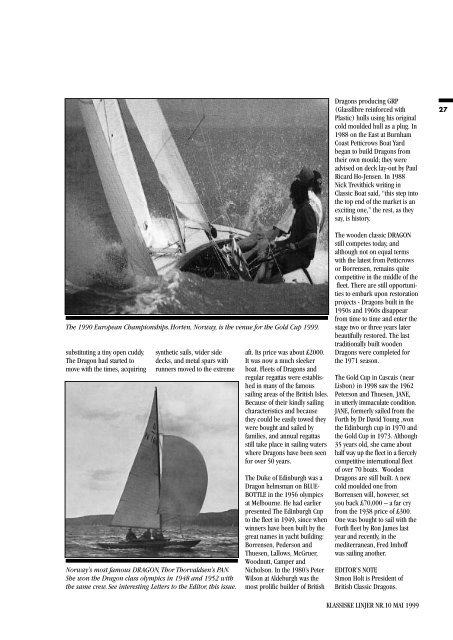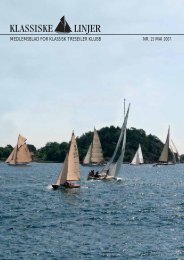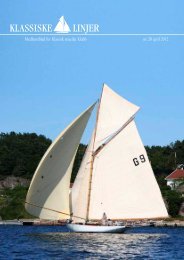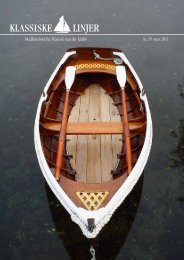Klassiske Linjer nr 10 1999 - Klassisk Treseiler Klubb
Klassiske Linjer nr 10 1999 - Klassisk Treseiler Klubb
Klassiske Linjer nr 10 1999 - Klassisk Treseiler Klubb
Create successful ePaper yourself
Turn your PDF publications into a flip-book with our unique Google optimized e-Paper software.
The 1990 European Championships. Horten, Norway, is the venue for the Gold Cup <strong>1999</strong>.<br />
substituting a tiny open cuddy.<br />
The Dragon had started to<br />
move with the times, acquiring<br />
synthetic sails, wider side<br />
decks, and metal spars with<br />
runners moved to the extreme<br />
Norway’s most famous DRAGON, Thor Thorvaldsen’s PAN.<br />
She won the Dragon class olympics in 1948 and 1952 with<br />
the same crew. See interesting Letters to the Editor, this issue.<br />
aft. Its price was about £2000.<br />
It was now a much sleeker<br />
boat. Fleets of Dragons and<br />
regular regattas were established<br />
in many of the famous<br />
sailing areas of the British Isles.<br />
Because of their kindly sailing<br />
characteristics and because<br />
they could be easily towed they<br />
were bought and sailed by<br />
families, and annual regattas<br />
still take place in sailing waters<br />
where Dragons have been seen<br />
for over 50 years.<br />
The Duke of Edinburgh was a<br />
Dragon helmsman on BLUE-<br />
BOTTLE in the 1956 olympics<br />
at Melbourne. He had earlier<br />
presented The Edinburgh Cup<br />
to the fleet in 1949, since when<br />
winners have been built by the<br />
great names in yacht building:<br />
Borrensen, Pederson and<br />
Thuesen, Lallows, McGruer,<br />
Woodnutt, Camper and<br />
Nicholson. In the 1980’s Peter<br />
Wilson at Aldeburgh was the<br />
most prolific builder of British<br />
Dragons producing GRP<br />
(Glassfibre reinforced with<br />
Plastic) hulls using his original<br />
cold moulded hull as a plug. In<br />
1988 on the East at Burnham<br />
Coast Petticrows Boat Yard<br />
began to build Dragons from<br />
their own mould; they were<br />
advised on deck lay-out by Paul<br />
Ricard Ho-Jensen. In 1988<br />
Nick Trevithick writing in<br />
Classic Boat said, “this step into<br />
the top end of the market is an<br />
exciting one,” the rest, as they<br />
say, is history.<br />
The wooden classic DRAGON<br />
still competes today, and<br />
although not on equal terms<br />
with the latest from Petticrows<br />
or Borrensen, remains quite<br />
competitive in the middle of the<br />
fleet. There are still opportunities<br />
to embark upon restoration<br />
projects - Dragons built in the<br />
1950s and 1960s disappear<br />
from time to time and enter the<br />
stage two or three years later<br />
beautifully restored. The last<br />
traditionally built wooden<br />
Dragons were completed for<br />
the 1971 season.<br />
The Gold Cup in Cascais (near<br />
Lisbon) in 1998 saw the 1962<br />
Peterson and Thuesen, JANE,<br />
in utterly immaculate condition.<br />
JANE, formerly sailed from the<br />
Forth by Dr David Young ,won<br />
the Edinburgh cup in 1970 and<br />
the Gold Cup in 1973. Although<br />
35 years old, she came about<br />
half way up the fleet in a fiercely<br />
competitive international fleet<br />
of over 70 boats. Wooden<br />
Dragons are still built. A new<br />
cold moulded one from<br />
Borrensen will, however, set<br />
you back £70,000 – a far cry<br />
from the 1938 price of £300.<br />
One was bought to sail with the<br />
Forth fleet by Ron James last<br />
year and recently, in the<br />
mediterranean, Fred Imhoff<br />
was sailing another.<br />
EDITOR’S NOTE<br />
Simon Holt is President of<br />
British Classic Dragons.<br />
KLASSISKE LINJER NR.<strong>10</strong> MAI <strong>1999</strong><br />
27






